So compared to other glasses models on the market like Meta Quest 3, is the rookie from Apple strong enough to beat the competition?
Although Meta Quest has been on the market for a long time, even reaching its 3rd version, the real explosion in virtual reality comes from Apple Vision Pro. The product from the "Apple" house is making waves in the market, this explosion can make users forget the presence of Meta Quest for a short time. Or, it can also make Meta Quest more noticeable.
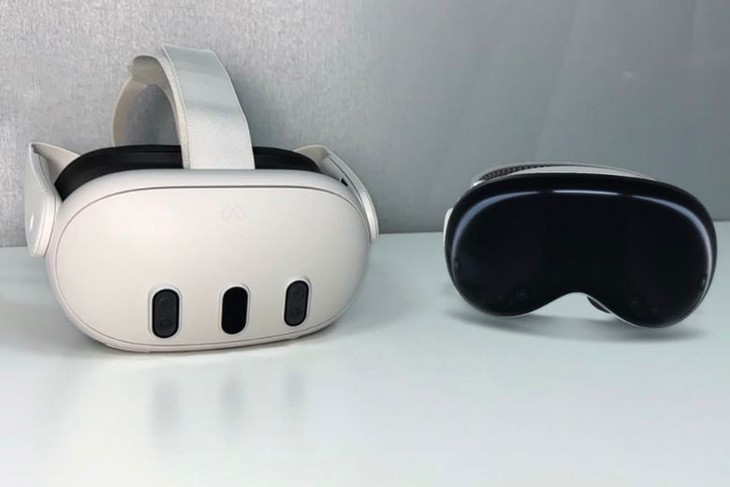 |
Design
Apple Vision Pro is designed with a modern look, using a glass front and aluminum frame. This makes the product thin and light and reduces the overall weight. When used, users will feel comfortable and pleasant.
Vision Pro does not have its own controller, the product uses eye recognition technology and hand gestures. In addition, Apple equips the glasses with a wireless controller from PS5, helping users experience smooth gameplay.
Meanwhile, the Meta Quest 3 is designed with three straps to best distribute the weight. This headset uses a thinner pancake lens than the Quest 2. The Meta Quest 3 controller is highly appreciated for its lightness and convenience.
In particular, users can combine with third-party accessories to create the feeling of holding a sword or racket during gameplay. These unique features and designs make Vision Pro and Meta Quest 3 an attractive choice, depending on the preferences and needs of each user.
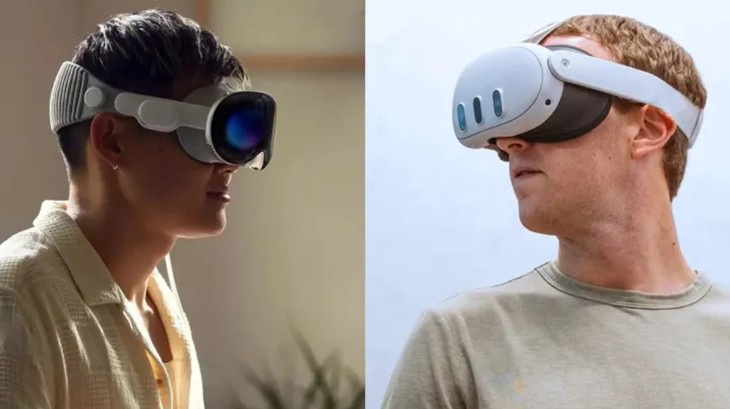 |
Weight
The Meta Quest 3 weighs 459 grams while the Vision Pro weighs around 600 grams. For some users, this number can be a barrier to the experience, as wearing the glasses on your head for a long time (more than 30 minutes) will feel uncomfortable and uncomfortable.
So, when comparing Apple Vision Pro with Meta Quest 3 in terms of weight, both products are still not as light as expected. But the brands are committed, the product will definitely bring a comfortable entertainment experience to users when wearing.
Eye tracking capabilities
In terms of hardware, Apple Vision Pro stands out with 12 cameras, a LIDAR sensor, a TrueDepth camera, and infrared illuminators. Meanwhile, the Meta Quest 3 has 6 sensors, including two RGB cameras that support mixed reality experiences.
In addition to offering virtual reality (VR) experiences, both headsets can also offer augmented reality (AR) experiences. While the Vision Pro delivers this with smooth eye tracking and hand gestures, the Meta Quest 3 comes with a pair of controllers to assist.
With Vision Pro, control is significantly more convenient because it is a standalone VR headset, independent of the accompanying accessories. Meanwhile, although it requires a controller, this is what makes Meta Quest 3 more useful for certain tasks, such as gaming.
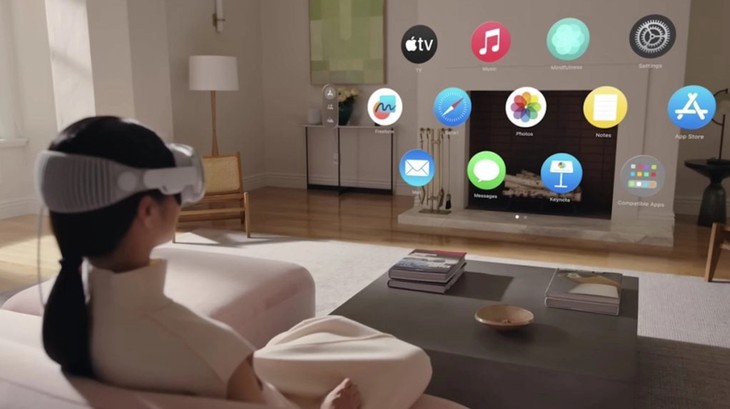 |
App and game store
Meta Quest 3 is said to have a superior advantage, because Quest is a product line that has been developed and commercialized for a long time (2016, under the name Oculus Rift). Thanks to that, the application store of this tool will also be more diverse, because the developers have worked on it very early. In addition, Apple Vision Pro has not focused on games. Meanwhile, Quest 3's application store also has many games to serve entertainment needs.
With Apple Vision Pro, the visionOS app store is said to be shared with iPadOS and iOS. This means that many of the tools available on iPhone and iPad will also be available on Vision Pro. Currently, 600 apps have been announced for the glasses, and when 250 games are available through Apple Arcade, it's pretty promising.
Image quality
Apple Vision Pro has two micro-OLED screens with a resolution of about 3,680 x 3,140 pixels, surpassing what is on Meta Quest 3 when this headset only has dual LCD screens with a resolution of about 2,064 x 2,208 pixels. According to many reviews, the image quality that Vision Pro brings is superior, especially in terms of passthrough, when the outside image appears in bright enough conditions is extremely sharp.
Additionally, apps and windows that appear on Vision Pro will also have better quality, due to the higher resolution of the glasses' screen. If Apple Arcade games run on these glasses, we will likely see sharp, vibrant graphics.
Meanwhile, with Meta Quest 3, according to many reviews, the image quality when playing games will still be a bit blurry and noisy.
Battery life
According to Apple, Vision Pro will last about 2 hours of normal use and 2.5 hours of video playback, which is basically the same as Meta Quest 3. However, unlike Meta Quest 3, Vision Pro will use a removable battery, must be connected and carried continuously to be able to use. Meanwhile, Quest 3 only needs to be pre-charged with a Type-C charger, fully charged to be able to use comfortably.
Selling price
Meta Quest 3 with a starting price of 13,490 million VND for the 128GB version of internal memory, Meta Quest 3 is much more reasonable than the more than 100 million VND of Apple Vision Pro. However, the Apple name doubles the internal memory to 256GB, equal to MacBook Air, ensuring the best data storage capacity if we want to use it instead of a laptop.
Suitable product?
Ignoring the price difference, in terms of technology, Apple Vision Pro can be considered a masterpiece in the world of virtual reality glasses, far surpassing other products such as Microsoft Hololens or Meta Quest 3 itself. If you are someone who values work experience and is using Apple products, wanting to have the ability to expand the maximum space, this will definitely be the most suitable name.
However, being just the first generation, the Apple Vision Pro will need time to be optimized. If you want an experience that is not bad at all at a more economical cost, the Meta Quest 3 is a good choice while waiting to see what else the Apple Vision Pro can show.
Source



![[Photo] Politburo works with the Standing Committees of Dong Thap and Quang Tri Provincial Party Committees](https://vphoto.vietnam.vn/thumb/1200x675/vietnam/resource/IMAGE/2025/9/8/3e1c690a190746faa2d4651ac6ddd01a)



![[Photo] Politburo works with the Standing Committees of Vinh Long and Thai Nguyen Provincial Party Committees](https://vphoto.vietnam.vn/thumb/1200x675/vietnam/resource/IMAGE/2025/9/8/4f046c454726499e830b662497ea1893)





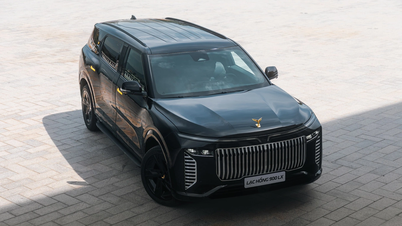








![[INFOGRAPHIC] Samsung Galaxy Buds3 FE Smart headphones, 30-hour battery](https://vphoto.vietnam.vn/thumb/402x226/vietnam/resource/IMAGE/2025/9/8/fa1a0e331dfc46e0830091378c32dc6c)


![[INFOGRAPHIC] Career of Thailand's new Prime Minister Anutin Charnvirakul](https://vphoto.vietnam.vn/thumb/402x226/vietnam/resource/IMAGE/2025/9/8/efe23bc6d3af4dc185b04cd5f92d3246)

![[Photo] Amazing total lunar eclipse in many places around the world](https://vphoto.vietnam.vn/thumb/1200x675/vietnam/resource/IMAGE/2025/9/8/7f695f794f1849639ff82b64909a6e3d)











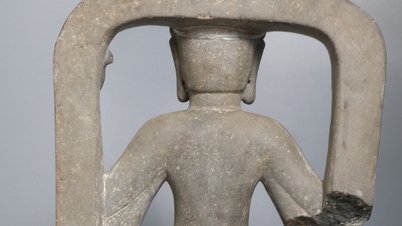

























































Comment (0)